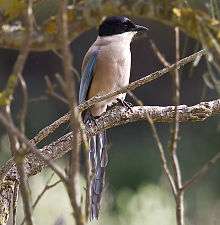Iberian magpie
The Iberian magpie (Cyanopica cooki) is a bird in the crow family. It is 31–35 cm long and similar in overall shape to the Eurasian magpie (Pica pica) but is more slender with proportionately smaller legs and bill. It belongs to the genus Cyanopica.
| Iberian magpie | |
|---|---|
 | |
| Scientific classification | |
| Kingdom: | Animalia |
| Phylum: | Chordata |
| Class: | Aves |
| Order: | Passeriformes |
| Family: | Corvidae |
| Genus: | Cyanopica |
| Species: | C. cooki |
| Binomial name | |
| Cyanopica cooki (Bonaparte, 1850) | |
| Synonyms[1] | |
|
Cyanopica cyana cooki | |
Other common names include Iberian azure-winged magpie,[1] Cook's azure-winged magpie and Spanish azure-winged magpie.[2]
It has a glossy black top to the head and a white throat. The underparts and the back are a light grey-fawn in colour with the wings and the feathers of the long (16–20 cm) tail are an azure blue. It inhabits various types of coniferous (mainly pine) and broadleaf forest, including parks and gardens in the eastern populations.
Distribution and habitat
The Iberian magpie occurs in southwestern and central parts of the Iberian Peninsula, in Spain and Portugal. However, it can sometimes be spotted also in south-western France,[3] and recently its presence has been reported even in northern Italy.[4] This taxon is usually treated as conspecific with azure-winged magpie C. cyana, but this population is 5400 miles (9,000 km) away from those in eastern Asia.[2] Recent genetic analysis has shown that the Iberian magpie and the azure-winged magpie are distinct at species level.[5]
Behaviour and ecology
Often Iberian magpies find food as a family group or several groups making flocks of up to 70 birds. The largest groups congregate after the breeding season and throughout the winter months. Their diet consists mainly of acorns (oak seeds) and pine nuts, extensively supplemented by invertebrates and their larvae, soft fruits and berries, and also human-provided scraps in parks and towns.
This species usually nests in loose, open colonies with a single nest in each tree.[6] There are usually 6–8 eggs that are incubated for 15 days.[7]
References
- "Cyanopica cooki". Avibase.
- Handbook of the Birds of the World vol 12. p. 598.
- "Iberian Magpie". oiseaux-birds.
- "Gazze aliazzurre in Lombardia". YouTube.
- Kryukov, A.; Iwasa, M. A.; Kakizawa, R.; Suzuki, H.; Pinsker, W.; Haring, E. (November 2004). "Synchronic east-west divergence in azure-winged magpies (Cyanopica cyanus) and magpies (Pica pica)". Journal of Zoological Systematics and Evolutionary Research. 42 (4): 342–351. doi:10.1111/j.1439-0469.2004.00287.x.
- Alonso, J.A.; Muñoz-Pulido, R.; Bautista, L.M.; Alonso, J.C. (1991). "Nest-site selection and nesting success in the azure-winged magpies Cyanopica cyana in central Spain". Bird Study. 38: 45–51. doi:10.1080/00063659109477066.
- Muñoz-Pulido, R.; Bautista, L.M.; Alonso, J.C.; Alonso, J.A. (1990). "Breeding success of azure-winged magpies Cyanopica cyana in central Spain". Bird Study. 37: 111–114. doi:10.1080/00063659009477046.
| Wikimedia Commons has media related to Cyanopica cooki. |
